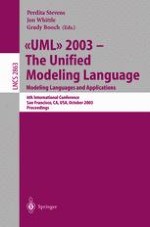2003 | OriginalPaper | Buchkapitel
Representing Temporal Information in UML
verfasst von : Jordi Cabot, Antoni Olivé, Ernest Teniente
Erschienen in: «UML» 2003 - The Unified Modeling Language. Modeling Languages and Applications
Verlag: Springer Berlin Heidelberg
Enthalten in: Professional Book Archive
Aktivieren Sie unsere intelligente Suche, um passende Fachinhalte oder Patente zu finden.
Wählen Sie Textabschnitte aus um mit Künstlicher Intelligenz passenden Patente zu finden. powered by
Markieren Sie Textabschnitte, um KI-gestützt weitere passende Inhalte zu finden. powered by
The UML is a non-temporal conceptual modeling language. Conceptual schemas in the UML assume that the information base contains the current instances of entity and relationship types. For many information systems, the above assumption is acceptable. However, there are some information systems for which that assumption is a severe limitation. This happens when the functions of the information system require the knowledge of past states of the information base. In this paper we extend the UML to define a set of temporal features of entity and relationship types, and to provide notational devices to refer to any past state of the information base. Using this extension, a designer may use the UML/OCL as if it were a temporal conceptual modeling language. We also present a method for the transformation of a conceptual schema in this extended language into a conventional one. The method can be automated, and we describe an implementation. The result of our transformation method is a conceptual schema that can be processed by ordinary CASE tools.
